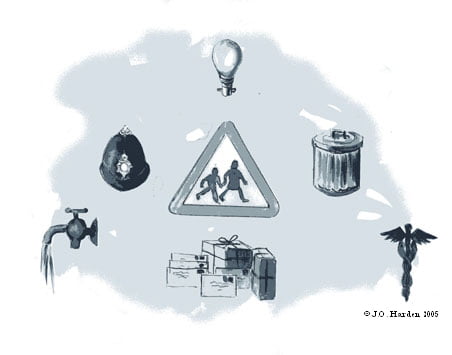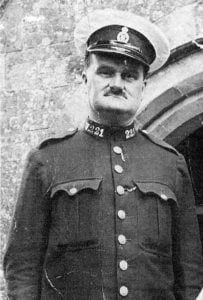
Fovant’s Policemen
Fovant benefitted early from the formation of a national police force for, in the 1841 census of the village, our first resident policeman is listed as:
- Jas. Mason, aged 30, Police Constable, and his wife Jane also aged 30, Dressmaker, listed as residents, and they were both native-born Fovant villagers.
In each successive census year up until 1901, beyond which details are not yet released, a village policeman is listed as a resident. Being subject to regular ‘postings’, they rarely stayed very long in any one area.
- 1851 William Brown, unmarried, aged 23, lodger, born in Sutton Waldren, Dorset.
- 1861 Martin Jefferies, married, aged 42, born Wooton Bassett, and his wife Mary born Alderbury. No address given.
- 1864 David White, married to Mary Rosetta, stepson Jephthah, daughter Flora Amanda.
- 1871 Sidney Carter, unmarried, 28, lodger, born Chitterne.
- 1881 Sidney Carter, now married, his wife Jane aged 40, born Sherrington, and their two children, both of whom were born in Fovant. No address given.
Unusually Sidney Carter stayed in Fovant for at least ten years.
- 1891 Henry King, married, aged 35, born in Castle Eaton, his wife Louisa aged 39, born in Calne, and their nine children, who were born variously at Alvediston, Semley and the last three in Fovant.
A village house, now called Westwood, on the area known as the Knap in Dinton Road, had by now been designated as the Police House. The Kings were the first police family to live in it.
- 1901 Alfred J. Perry, aged 29, married, born in Stanton St Bernard, Wiltshire, his wife Sarah aged 29, born in Crewkerne and their children both of whom were born in Fovant. Listed as living on the Knap.
Although further regular records are not yet available to us, Kelly’s Directories give Charles Harry Smith as our village policeman in 1915 and an unnamed police constable in 1930. It was undoubtedly sometime during this period that the following incident is likely to have occurred:
‘The village policeman saw to it that law and order were respected. The policeman was indeed a law unto himself, administering rough justice to the boys of the village when he caught them in a misdemeanour or minor crime. Physical punishment was never held against him by his victims, so the offender found that any appeal to his parents seldom had any effect. There was an instance when a boy was beaten by a policeman, so Father told me, he complained to his father expecting sympathy. All he got was a second beating, this time by his own father, who said,” Well, if he thought to beat you, you must have been doing something wrong. So I’ll give you a hiding as well, to teach you not to do it again.” Thus was justice doubly served.’
Extract from ‘The Life and Times of a Wiltshire Farmer’ by Bob Combes.
 The unnamed policeman of 1930 was probably the last of our village policemen to live on the Knap, for in the early 1930s a purpose built police house was constructed. It was situated a little way out of the village on the A.30, in the direction of Salisbury. Apparently, siting a village police house outside a village was a common police practice in order to discourage the policeman from fraternising with the villagers too much. It is doubtful if the policy was very successful.
The unnamed policeman of 1930 was probably the last of our village policemen to live on the Knap, for in the early 1930s a purpose built police house was constructed. It was situated a little way out of the village on the A.30, in the direction of Salisbury. Apparently, siting a village police house outside a village was a common police practice in order to discourage the policeman from fraternising with the villagers too much. It is doubtful if the policy was very successful.
A succession of village policeman, Police Constables Russell, Bond, Rawlings and finally Martin, then followed each other in the Police House on the A30. Tony Martin was a Traffic Officer rather than an actual village policeman. The local feeling is that the lay-by, which was made fronting the house at a date later than the original construction, was intended for police vehicles. With the building of the new police station at Tisbury in 1974, it was felt that a resident police presence in the village was no longer necessary. Fovant then came under the general jurisdiction of the Tisbury and Mere Constabulary, within which the village became the responsibility of Tisbury-based Community Policemen.
J.O.H.
2005
Content last updated
21 December 2006
